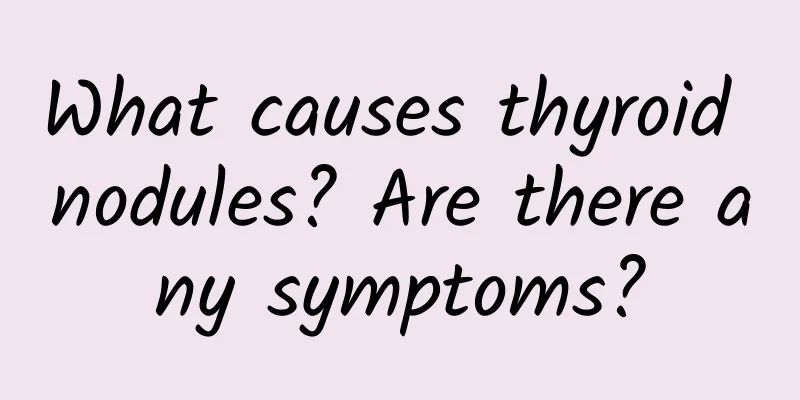What causes thyroid nodules? Are there any symptoms?

|
Author: Fang Jugao, Chief Physician, Beijing Tongren Hospital, Capital Medical University Deputy Director of the Head and Neck Surgery Group of the Otorhinolaryngology and Head and Neck Surgery Branch of the Chinese Medical Association Reviewer: Wei Junping, Chief Physician, Guang'anmen Hospital, China Academy of Chinese Medical Sciences Deputy Director of the Integrated Traditional Chinese and Western Medicine Group of the Endocrinology Society of the Chinese Medical Association The thyroid gland is an endocrine gland that is responsible for the body's metabolism and is mainly related to energy metabolism, so some people figuratively call it the "nuclear power plant" in the human body. The normal thyroid gland is a relatively homogeneous and soft tissue. In the normal thyroid tissue, uneven changes occur, forming nodules of varying sizes, which are called thyroid nodules. Figure 1 Original copyright image, no permission to reprint The incidence of thyroid nodules is very high. When people over 40 years old go for a physical examination, more than 40% will be found to have thyroid nodules. So, what causes thyroid nodules? 1. What causes thyroid nodules? There are many causes of thyroid nodules, which can be roughly divided into the following categories. Nodular goiter is when many nodules form in the thyroid gland, causing the thyroid to enlarge and the neck to become thick. Common people call this thick neck disease. This is because there is a lack of iodine in the food. During the synthesis of thyroid hormones, due to insufficient iodine intake, the thyroid follicles with endocrine function of the thyroid gland gradually grow larger and form nodules. This is a common cause of thyroid nodules. Hashimoto's disease, also known as lymphocytic thyroiditis, is caused by an unbalanced autoimmune state of the thyroid gland, which can also lead to hyperplasia of thyroid cells and proliferation of lymphocytes between follicles, causing nodular changes in the thyroid gland. Thyroid adenoma or thyroid cancer will also form nodules. Due to certain reasons, the cells in the follicles proliferate, benign proliferation forms adenoma, and malignant proliferation turns into thyroid cancer. 2. What are the symptoms of thyroid nodules? Thyroid nodules are relatively small and generally have no symptoms. When they grow to a certain size, a lump will appear below the Adam's apple, on both sides of the trachea, or in front of it. If it grows particularly large, it may compress the trachea, causing difficulty in breathing; compress the recurrent laryngeal nerve, causing hoarseness; compress the esophagus, causing difficulty in swallowing and affecting eating. Benign thyroid nodules, if they lead to hyperthyroidism or hypothyroidism, will cause abnormal energy metabolism in the body. Hypothyroidism and insufficient energy metabolism can cause fear of cold, unwillingness to talk, unwillingness to eat, and laziness to move. In severe cases, it can cause systemic myxedema and even cardiac myxedema, leading to heart disease. Hyperthyroidism can cause symptoms such as hot body, irritability, bad temper, weight loss, rapid heartbeat, palpitations and shortness of breath. Malignant thyroid nodules are also called thyroid cancer. Most thyroid cancers are adenocarcinomas, which grow slowly, but they will still grow and can invade surrounding organs, such as the recurrent laryngeal nerve, trachea, esophagus, etc. Thyroid cancer may also metastasize to the lungs, liver, bones, etc., causing systemic spread, which is very harmful. 3. What examinations can detect thyroid nodules? There are mainly two types of examinations, one is B-ultrasound examination, and the other is blood test. Figure 2 Original copyright image, no permission to reprint The most commonly used and convenient means of examination is B-ultrasound. Under B-ultrasound, the thyroid gland can be seen very clearly, and it can be used to preliminarily determine whether there are any structural changes in the thyroid gland, whether there are any nodules, and to preliminarily determine whether the thyroid nodules are benign or malignant. If you suspect there is a problem with thyroid function, you need to resort to laboratory tests and blood tests to check thyroid function indicators. Blood tests cannot determine whether a thyroid nodule is benign or malignant. B-ultrasound and blood drawing can be used to preliminarily determine, first, whether there are thyroid nodules; second, whether the thyroid nodules are benign or malignant; and third, whether the thyroid function is normal. After comprehensive analysis and consideration based on these examinations, the doctor believes that thyroid nodules are not likely to be malignant. Benign nodules smaller than 4 cm and with normal thyroid function generally do not require treatment and only require observation. An ultrasound should be performed every one or two years to observe the development of the nodules. When a benign nodule is particularly large, growing larger than 4 cm, it may cause local compression symptoms, such as compression of the trachea and esophagus, and then needs to be treated. If malignancy is suspected, further examination and diagnosis are required, such as ultrasound angiography, or puncturing the nodule under ultrasound guidance to obtain cellular components and perform pathological examination to see whether there are cancer cells to further clarify the diagnosis. Many patients with benign thyroid nodules are told by doctors to observe first without any treatment. They will be very anxious and worry that the benign nodules will become malignant. In fact, the rate of malignant transformation of benign thyroid nodules is very low, and only a very small part will develop into thyroid cancer, so there is no need to worry too much. Even if it is malignant, there is no need to panic. Most thyroid cancers are well-differentiated adenocarcinomas. Early and mid-stage thyroid cancers can be cured through surgery and will not affect life expectancy. |
<<: The color of urine is like black tea, or red, white, or green. What’s going on?
>>: How do diabetics monitor their blood sugar at home? What is considered hypoglycemia?
Recommend
What are the side effects of taking diet pills during menstruation?
In order to have a better body shape, some female...
Gartner: Global PC shipments fell 9.6% in Q1 2016
According to preliminary statistics from Gartner,...
Numbness in the hands during the second trimester is a sign of miscarriage
Numbness in hands and feet is a common problem in...
How to exercise to tighten the vagina
Women who have given birth may have this feeling:...
Is the fabric of the Chanel-style suit easy to pill? What season is the Chanel-style suit suitable for?
The fabric of Chanel style suits is generally mad...
Breaking the "intestinal" rule! Changsha Fourth Hospital's precise surgery helps a 94-year-old intestinal cancer patient regain his life
For a long time, advanced age has been regarded a...
What does Yanggong patch discharge?
In daily life, many women have to deal with some ...
There are some tips for losing weight by walking fast, but 90% of people don’t know
Nowadays, various ways to lose weight are emergin...
Understand what is ICL lens implantation? Who can undergo ICL lens implantation?
References: Chen Li. ICL artificial lens implanta...
IDC: Global smartphone shipments to reach 1.17 billion units in 2023, down 3.2% year-on-year
2023 is a special year. The advancement and appli...
Depressive symptoms and chronic kidney disease are mutually causal, promoting each other and accelerating deterioration
Chronic kidney disease (CKD) is a major risk fact...
Can I take a shower when I have my period?
A woman's body is in a very fragile state dur...
Why do you have stomach pain in early pregnancy?
For mothers who are pregnant for the first time, ...
Silicone rhinoplasty has so many advantages
Recently, with the development of the Internet, m...
Overview of Breast Cysts
Brief description of breast cysts. Mammary cyst i...









